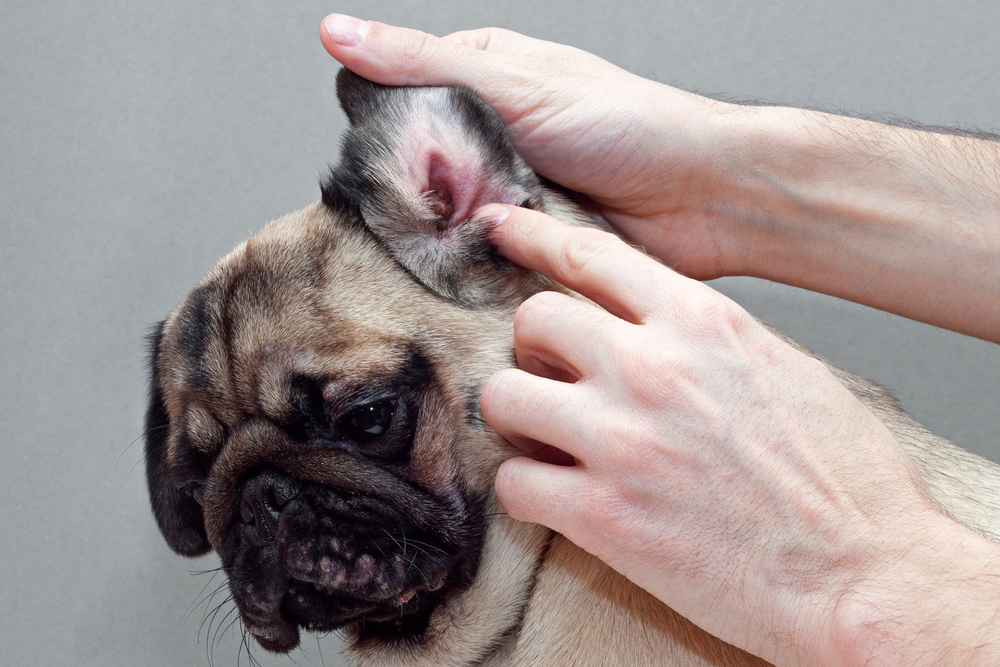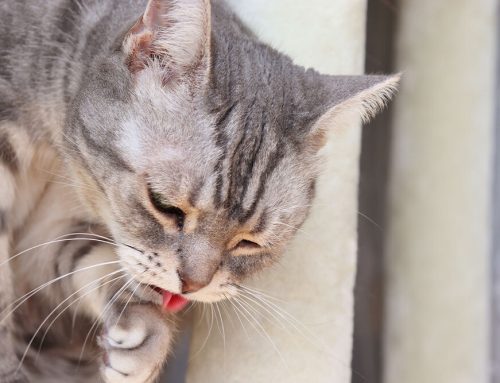Many pets are prone to ear infections, and affected pets can experience complications, such as hearing loss and neurological signs, if their condition is not managed appropriately. Our Stack Veterinary Hospital team provides information about pet ear infections and offers tips to help decrease your pet’s risk.
Pet ear infection types
Pet ear infections are classified according to the part of the ear infected. Classifications include:
- Otitis externa — An external ear canal infection is called otitis externa. Signs include redness inside the ear, ear discharge, head shaking, scratching at the affected ear, and odor from the ear.
- Otitis media — When the air-filled area behind the eardrum is affected, the condition is called otitis media. These infections typically occur when otitis externa progresses, but an ascending infection from the nasopharyngeal region sometimes can lead to this condition. Nerves that innervate the face and eyelid run through the middle ear, and damage to these nerves can result in facial nerve paralysis and dry eye.
- Otitis interna — An infection in the semicircular canals and cochlea is called otitis interna. Inflammation in this area, which contains the hearing apparatus and is responsible for maintaining the pet’s balance, can lead to complications such as hearing loss, head tilt, incoordination, and involuntary eye movements.
Pet ear infection causes
The pet’s ear normally contains bacteria and yeast, but when conditions allow these pathogens to multiply in excess, infection occurs. Conditions that can lead to pet ear infections include:
- Parasites — Parasites, such as ear mites and ticks, can cause ear infections, and cause the majority of ear infections in cats.
- Allergies — Allergies are a common problem for pets, and typically result in dermatitis issues. Allergic dermatitis results in weakened skin barriers, including inside the ear, which can lead to ear infections.
- Foreign bodies — Foreign bodies, such as plant material, hair, and soil, can provide food for bacteria and yeast, resulting in infection.
- Endocrine disorders — Certain endocrine disorders can decrease the pet’s infection-fighting ability and lead to ear infections.
- Growths — Malignant and benign growths inside the ear can result in infection.
- Viruses — Ascending viral infections from the nasopharyngeal region can lead to ear infections, especially in cats.
Pet ear infection predisposing factors

Certain conditions can increase your pet’s risk for ear infections, including:
- Ear conformation — A human’s ear canal travels horizontally from the tympanic membrane to the outside, whereas your pet’s ear canal has a horizontal and a vertical component, creating an L shape that promotes wax and debris accumulation. This accumulated material provides food for pathogens and predisposes pets to ear infections.
- Excess moisture — Pets who love the water and swim frequently develop moisture inside their ear, which can make them prone to ear infections.
- Floppy ears — Dogs such as basset hounds, who have long, floppy ears, are predisposed to ear infections, because their ear structure is an ideal environment for pathogen growth.
- Narrowed ear canals — Dogs such as Shar peis, who have narrowed ear canals that prevent appropriate drainage, are predisposed to ear infections.
- Hairy ears — Dogs such as cocker spaniels, who have excess hair growing in their ear canals, are at higher risk for ear infections.
Pet ear infection treatment
An underlying condition, such as allergic dermatitis, that is causing the ear infection, must be addressed to resolve the problem. Typically, our veterinary team takes a sample from your pet’s ear to determine what pathogen is causing the infection. Possible treatments include:
- Deep ear lavage — Our veterinary team will closely evaluate your pet’s ear canal and tympanic membrane and lavage the area to remove wax and debris. Frequently, pets in significant pain need heavy sedation or general anesthesia for this procedure.
- Ear cleaning — Ongoing ear cleaning is typically necessary to resolve the infection, and we will recommend an appropriate ear cleaning product.
- Topical medications — Topical antimicrobials are usually sufficient to treat uncomplicated ear infections, and we will prescribe an appropriate medication based on your pet’s culture results.
- Systemic medications — In some cases, systemic antimicrobials and pain medications are necessary to resolve the ear infection and help alleviate pain.
- Surgery — In severe cases, surgery is necessary to remove the damaged ear tissue and help resolve the infection.
Pet ear infection prevention
Not every pet ear infection case can be prevented, but you can take steps to decrease your pet’s risk. Tips include:
- Cleaning your pet’s ears — If your pet is prone to ear infections, clean their ears every two to four weeks, and check daily for infection evidence.
- Drying your pet’s ears — Dry your pet’s ears thoroughly after swimming and bathing to remove any excess moisture.
- Following veterinary directions — When topical or systemic medications are prescribed, ensure you finish the treatment course to prevent recurrence.
- Addressing underlying conditions — Bring in your pet for regular wellness visits, so we can detect and address underlying conditions before they lead to ear infections and other problems.
- Seeking veterinary attention — At the first sign of an ear infection, bring in your pet for veterinary care, so we can treat the problem before the infection can progress.
Ear infections are problematic for pets, but following these tips should help decrease your pet’s risk. If your pet has a painful ear, contact our American Animal Hospital Association (AAHA)-accredited Stack Veterinary Hospital team, so we can devise a treatment strategy to alleviate their distress.







Leave A Comment